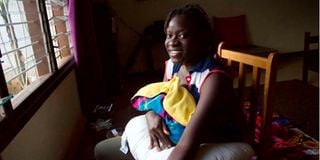Why I opted to have a water birth as a first-time mother

Loi Awat, 31, breastfeeding her son.
What you need to know:
- I researched extensively through books, documentaries, YouTube, and podcasts so by the time I was getting pregnant at 29 years, I knew a lot about home births
- Through research, we found that water is a natural pain reliever, as it helps to relax the muscles
"Even before I got pregnant, my partner (Adam Chienjo) and I had already decided that we wanted a home birth. For most professional women in Kenya, this is an option they wouldn't pick if it was offered to them. There are always fears and "what if" that mostly stem from a place of lack of information about the process.
I researched extensively through books, documentaries, YouTube, and podcasts so by the time I was getting pregnant at 29 years, I knew a lot about home births. My pregnancy journey in 2019 was mostly smooth except for occasional nausea. My mother was super excited and you can imagine that she had stashed for me some baby clothes from three decades ago?
For weeks, I had pondered on how to tell her about my decision. Seeing how she anticipated the baby, I couldn't continue keeping it to myself. Surprisingly, she was supportive of the idea and reminded me of the many women who give birth at home whether by choice or circumstance. "We, however, need to take some precautions," she advised. We organised for an ambulance at the cost of Sh2,500, just in case complications arose.
Because it would be out of a hospital and there would be no pain interventions available, I settled on a water birth with two midwives attending. The total cost was Sh150,000. The next thing was to prepare for it psychologically and physically and to make sure our home was delivery ready.
"Why a water birth?" this is a question I am often asked.
Through research, we found that water is a natural pain reliever, as it helps to relax the muscles. Giving birth in water is also a gentler way of introducing the baby to the world, as they come from a water-based environment in the womb. For someone looking for alternative birth methods, the majority of Kenyan hospitals do not offer water births- except for Agha Khan. That's how limited the options were.
I first saw my main midwife on YouTube, years before I was even pregnant. I sent her an email and visited her birthing centre (before the ministry changed the registration policies, so they were still in operation). During my pregnancy journey, I stuck with her, took her labour preparation class, and booked her for the home birth.
I was mainly looking for someone that was on the same page as me regarding the birth process, women's bodies, and how we are designed by God. Going by her YouTube videos, she was a good pick.
On the material day, when I was about 4 cm dilated, the midwife instructed me to take a walk and instructed my partner to start filling the inflatable tub. The water is supposed to be hot. The tub takes in 120 litres of water, so he was dragging pipes and kettles and it was chaotic.
Then I started feeling the famous urge to poop. The only sound you can make is that deep guttural growl. I was ready to push at that point. On one hand, my partner was still scrambling to get things ready as the water level wasn't where it's supposed to be. On the other hand, I was growling in pain and was impatiently giving him orders. I could see on his face that he was being patient with me. The lead midwife was very strict and stern with me, which calmed me down.
I recall her saying the baby was crowning, and I should reach out to feel. It felt very foreign, and I pulled my hand away very fast! I took a sitting position and was coached to relax my thighs and start pushing. As I was doing it, I felt the baby come out of the birth canal and it was such a strange feeling. Then, there was happiness and excitement. I cried a lot at that very moment.
For complications, there was a second-degree tear when the baby came out, and that needed to be stitched. For that, they had to use anesthesia. This became the hardest part of the delivery since the tear was irregular, I was bleeding and she was having a hard time seeing where the bleeding was coming from. After a while, the anesthesia wore off and I could feel the needle. I had to be injected again. Thankfully, my midwives were well prepared, and looking back, it was an amazing experience.
In as much as I highly champion home births, it is important to note that it is not recommended for every pregnancy. In addition, you have to "qualify" to be approved, which includes having no complications in your pregnancy, and all your markers (blood pressure, blood sugar, haematology, etc) being optimal. I got approval from both the midwife and my gynaecologist cum obstetrician. Our son, who is now two, has been a great addition to our blended family. He is very healthy and big for his age."
Feedback to the editor: [email protected]




